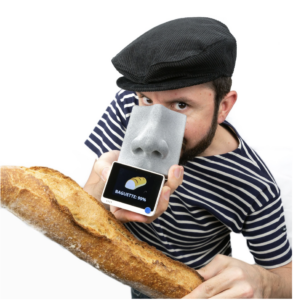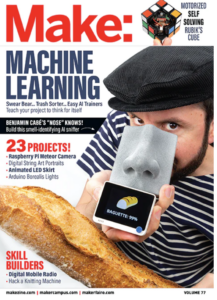
The Zephyr Project is excited to announce that Benjamin Cabé has joined the Linux Foundation team as a Developer Advocate. He is a technology enthusiast with a passion for empowering developers to build innovative solutions. He has over 15 years of experience leading developer engagement initiatives with some of the top communities and companies in the IoT, embedded, and AI.
He has invented an award-winning open source and open hardware artificial nose that he likes to use as an educational platform for people interested in diving into the world of embedded development. Benjamin lives in Toulouse, France, where he enjoys baking sourdough bread with the help of his artificial nose.
If you’re going to Embedded World, hosted on March 14-16 in Nuremberg, Germany, you can stop by the Zephyr Project booth (Hall 4-170) to chat with him and ask about his artificial nose. Or, you can register to meet him at the IoT Stars event on March 14 from 6-9:30 pm. Use the FRIEND-OF-ZEPHYR code for a 25% discount.
Learn more about Benjamin in this Q&A:
How long have you been active in open source?
I have been active in open source for pretty much my whole professional life.
Tell us about your favorite open source project and what problems did it aim to solve?
It’s really hard to name just one, but I do love the story of the MQTT protocol and how it took over the world at the beginning of the last decade.
MQTT is a lightweight messaging protocol that was invented in the late 90s to help monitor oil pipelines remotely over satellite communications. When IBM decided to open-source their MQTT client stacks in 2011, under the umbrella of the Eclipse Paho open source project, it basically unleashed the adoption of the protocol in the IoT space. For the following years, MQTT established itself as the de facto standard for IoT messaging, and eventually became an actual ISO/IEC standard.
How familiar are you with Zephyr? How long have you been active in the Zephyr community?
I’ve been lucky enough to have spent the last 10 years or so advocating for the use of open source software in the IoT and embedded space, and Zephyr has been on my radar pretty much from day one.
I have never been as actively involved as I had hoped until I started as a Developer Advocate, but I’ve always kept an eye on the project and its community.
What are your goals as the new dev advocate?
Zephyr is already an incredibly popular and active open source project, and the community is really passionate about “doing the right thing.” That being said, there’s probably a lot that can still be done to help newcomers get started with Zephyr even quicker. I want to help make sure that everyone can be virtually just a few clicks and a few minutes away from running their first Zephyr application on their favorite board.
I also hope to build more cross-pollination between Zephyr and other open source (or commercial, for what it’s worth!) projects that are already out there. We are already featuring some really nice examples of how to do TinyML or run embedded GUIs on Zephyr, for example, but not everyone is aware of their existence.
How do you want to help engage the community and grow the ecosystem?
I am repeating myself here, but Zephyr is a very rich and vibrant project. It implements lots of features—many of which being hidden gems—that are critical for building modern embedded applications, but there is always going to be a need for additional “bricks.” And there are many players, both open source and commercial, that are already building those bricks. I want to help make some noise and demonstrate cool end-to-end use cases that leverage both Zephyr proper and all the technologies and products out there that can take it even further.
Where do you see Zephyr Project in three years?
While Zephyr has originally had a strong “IoT” focus, it is in fact so much more than “just” an IoT embedded framework. First and foremost, it is a really solid real-time operating system, which in itself makes it a great candidate for powering virtually any embedded applications. We are already seeing the likes of Google shipping Zephyr-based firmwares at the heart of their Chromebooks, and we will see more of that for sure.
Zephyr has a strong focus on security and there are ongoing efforts to make it a suitable solution for use in safety-critical systems, and eventually release a version of it that is compliant with the IEC 61508 safety standard.
What is the biggest strength of the Zephyr community?
It takes a village to build an RTOS as rich as Zephyr, and the community is bringing a lot of complementary skills to the table. I think one of the biggest strengths of this community is its diversity. There is a great mix of individual contributors and companies involved, that help steer the project in a direction that is both technically sound and commercially viable.
What technology can you not live without? Why?
Like many others, and for better or worse, it’s probably my smartphone.
But I also have my “low-tech” moments, in particular since I recently developed an addiction to all things ceramics, and take a lot of pleasure in making the most of clay with only my hands and a few tools. If this peaked your interest, you may want to follow my journey on Instagram!
What part of the world do you live in? Why do you love where you live?
I’ve lived in Southern France, near the city of Toulouse, for my entire life.
It is a beautiful region that rewards you with a really nice weather, nice food obviously, and the luxury of being just a few hours away from both the beautiful Pyrenees mountains, and the Mediterranean sea.
What’s your favorite quote?
“Creativity is just connecting things.” – Steve Jobs. Full quote here: https://www.goodreads.com/quotes/1031045-creativity-is-just-connecting-things-when-you-ask-creative-people
At the beginning of the pandemic, in May of 2020, I decided to build an artificial nose that could help me improve my bread recipe by “smelling” the quality of my sourdough starter. I ended up building a fully open source and open hardware device I have been using ever since as a way to help people understand some of the key concepts of typical IoT solutions, and the project was even featured on the cover of MAKE: Magazine!
